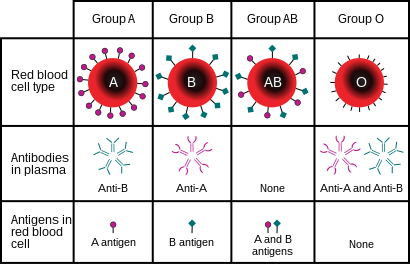
Back نظام الزمر الدموية ABO Arabic ABO sistem krvnih grupa BS Sistema d'agrupament sanguini AB0 Catalan Krevní systém AB0 Czech AB0 Danish AB0-System German އޭބީއޯ ލޭގެ ގުރޫޕްގެ ނިޒާމް DV Sistema de grupos sanguíneos ABO Spanish AB0-süsteem Estonian سیستم گروه خونی ABO Persian

The ABO blood group system is used to denote the presence of one, both, or neither of the A and B antigens on erythrocytes (red blood cells).[1] For human blood transfusions, it is the most important of the 44 different blood type (or group) classification systems currently recognized by the International Society of Blood Transfusions (ISBT) as of December 2022.[2][3] A mismatch in this serotype (or in various others) can cause a potentially fatal adverse reaction after a transfusion, or an unwanted immune response to an organ transplant.[4] Such mismatches are rare in modern medicine. The associated anti-A and anti-B antibodies are usually IgM antibodies, produced in the first years of life by sensitization to environmental substances such as food, bacteria, and viruses.
The ABO blood types were discovered by Karl Landsteiner in 1901; he received the Nobel Prize in Physiology or Medicine in 1930 for this discovery.[5] ABO blood types are also present in other primates such as apes, monkeys and Old World monkeys.[6]
- ^ Schreiber BA, Curley R, Gaur A, Rodriguez E, Rogers K, Sinha S (18 July 2017). "ABO blood group system". Encyclopædia Britannica. Encyclopædia Britannica, Inc. Retrieved 26 October 2017.
- ^ "ISBT: Red Cell Immunogenetics and Blood Group Terminology". www.isbtweb.org. Archived from the original on 2 February 2022. Retrieved 25 April 2023.
- ^ Storry JR, Castilho L, Chen Q, Daniels G, Denomme G, Flegel WA, et al. (August 2016). "International society of blood transfusion working party on red cell immunogenetics and terminology: report of the Seoul and London meetings". ISBT Science Series. 11 (2): 118–122. doi:10.1111/voxs.12280. PMC 5662010. PMID 29093749.
- ^ Muramatsu M, Gonzalez HD, Cacciola R, Aikawa A, Yaqoob MM, Puliatti C (March 2014). "ABO incompatible renal transplants: Good or bad?". World Journal of Transplantation. 4 (1): 18–29. doi:10.5500/wjt.v4.i1.18. PMC 3964193. PMID 24669364.
- ^ Maton A, Hopkins J, McLaughlin CW, Johnson S, Warner MQ, LaHart D, Wright JD (1993). Human Biology and Health. Englewood Cliffs, New Jersey, USA: Prentice Hall. ISBN 978-0-13-981176-0.
- ^ Ségurel L, Thompson EE, Flutre T, Lovstad J, Venkat A, Margulis SW, et al. (November 2012). "The ABO blood group is a trans-species polymorphism in primates". Proceedings of the National Academy of Sciences of the United States of America. 109 (45): 18493–8. arXiv:1208.4613. Bibcode:2012PNAS..10918493S. doi:10.1073/pnas.1210603109. PMC 3494955. PMID 23091028.